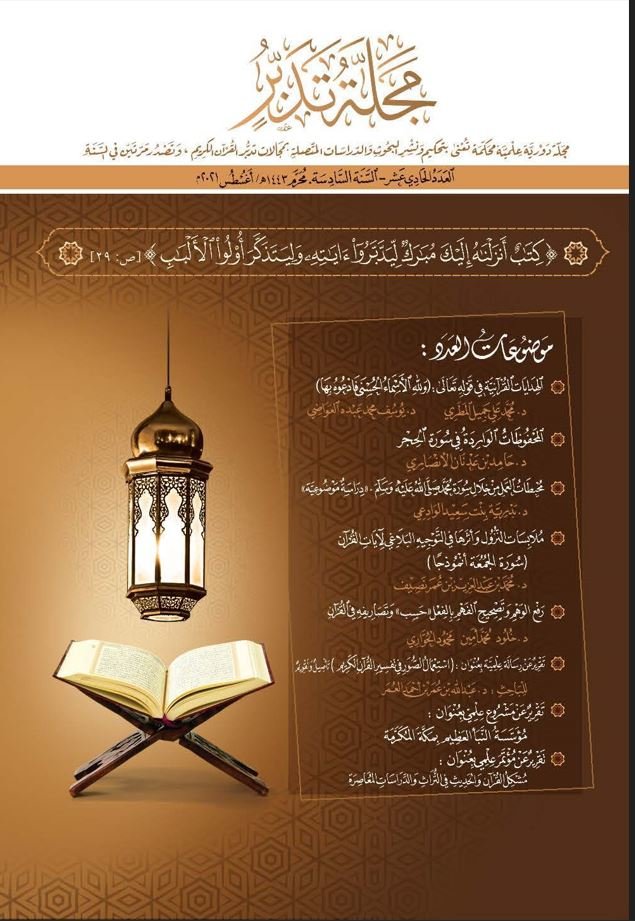رفع الوهم وتصحيح الفهم بالفعل "حسب" وتصاريفه في القرآن.
محتوى المقالة الرئيسي
الملخص
قصدت الدّراسة إلى استنباط أساليب القرآن وأدواته في رفع الوهم وتصحيح الفهم، ومعرفة دلالة (حسب) ودوره في ذلك في الاستعمال القرآني، ودراسة المفاهيم المرجوحة المبنية على حسبانٍ باطل ونظرٍ عقليٍّ قاصر توهمه أصحابه، وبيان دفعها وبطلانها تأصيلًا لسديد الفهم، وقائدًا لتقويم السلوك.
وقد بلغت ثلاثة عشر مفهومًا، من مهمات العقيدة والسلوك، في أربعة وثلاثين موضعًا بـ(حسب) وتصاريفه.
وسلكت الدّراسة لتحقيق ذلك المنهج الاستقرائي في تتبع آيات يستنبط منها أساليب تصحيح الفهم، وآيات فعل (حسب) القلبي وتصاريفه، ثم تصنيفها في مفهوم جامع ينتظمها، وكذلك تتبع آيات أخرى تدفع الوهم ذاته، وتحقق الفهم بغير (حسب) وإثباتها في الهامش؛ بيانًا وإثراء، ثم المنهج التحليلي الاستنباطي في تحليل الشواهد، وتدبرها، وبيان صاحب الحسبان المتوهم، ومتعلقه، وجوابه.
وقد خلصت الدراسة إلى نتائج أهمها:
- تنوع أساليب القرآن العظيم وأدواته في رفع الوهم وتحقيق الفهم، وإزالة ما قد يشوش على الحقيقة أو يزين الباطل.
- أنّ (حسب) القلبي منقول من (حسب) الحسي، فكأن صاحب الحسبان أجرى عملية حساب وتدقيق ونظر عقلي، أثمرت تصوره وحسبانه.
- إفادة (حسب) اعتقاد الرجحان مقتربًا من الجزم ومترددًا إلى اليقين؛ فهو يقين مبني على أمارات العلم والنظر، مشوب بالشك، يحكم فيه الحاسب لأحد النقيضين، من غير أن يخطر الآخر بباله.
- مراعاة الاستعمال القرآني تلك الدلالة الدقيقة للفعل (حسب) في التنبيه على أوهام تصورها أصحابها بعد نظر عقليٍّ فاسد وتأملٍ أعمى، أفضى بهم إلى مفاهيم خاطئة، وتصورات باطلة، فكان (حسب) داع إلى تصحيح تلك المفاهيم الدعيّة على العلم والحساب الدقيق.
وانقدحت عنها توصيات أهمها: دراسة أساليب القرآن العظيم وأدواته في رفع الأوهام وتصحيح الأفهام؛ دراسة شاملة محكمة في أطروحة علمية.
##plugins.themes.bootstrap3.displayStats.downloads##
تفاصيل المقالة
القسم

هذا العمل مرخص بموجب Creative Commons Attribution-NonCommercial 4.0 International License.
وفقًا لمبادرة بودابست 2002م؛ توفر مجلة تدبر والتي تصدر عن مكتب خبرات طيبة للبحوث والدراسات بالمدينة المنورة الوصول الحر المجاني إلى إصداراتها، وتُطبِّق رخصة المشاع الإبداعي:
نَسب المُصنَّف – غير تجاري 4.0 دولي (Attribution- Non-Commercial 4.0 International (CC BY-NC 4.0)) للأعمال التي تنشرها من الأبحاث العلمية المحكمة والتقارير، والمتاحة مجانًا في شبكة الانترنت، وأنها تسمح لأي مستعمل بأن يقرأ، يُحمل، ينسخ، يوزع (تحويل)، يطبع، يبحث، أو ينشأ روابط نحو النصوص الكاملة لأبحاث المجلة وإصدارتها، وتحليلها آليا بغرض تكشفيها، أو إرسالها كبيانات للبرمجيات، أو استعمالها لأي هدف قانوني آخر، دون حواجز مالية، قانونية، أو تقنية أخرى تتجاوز تلك المتعلقة بالنفاذ للإنترنت في حد ذاته.
كما يمكنكم الاطلاع على سياسات المجلة للوصول المفتوح من هنا





